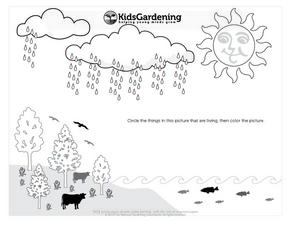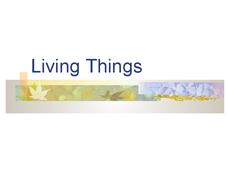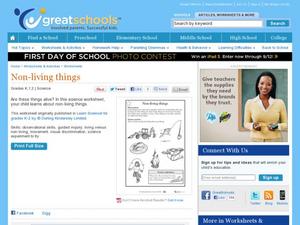North Clackamas Schools
Sorting Living and Nonliving Objects
Is a rock living? How about lima beans? You'll find everything you need for an interactive sorting activity exploring living and non-living things.
Kindergarten Kindergarten
Living and Non-Living Sort
What do an ice cream cone, bicycle, and alarm clock all have in common? That's exactly what young scientists will find out as sort these pictures and learn about the differences between living and non-living things.
Practical Money Skills
Living on Your Own
Every teen dreams of living independently, but often without thinking about the details and costs involved with moving out. Three lessons in a unit about living on your own focus on moving costs, fixed and flexible costs associated with...
Pace University
Grade 6-8 Living Things
What characterizes a living thing? Scholars explore the concept during a differentiated instruction unit on living things. They perform lab experiments to determine how animals adapt to stimuli, watch videos and learn about...
Curated OER
Living-Nonliving
Students determine that environments have living and nonliving parts. They discuss what makes something a living thing and something a nonliving thing. They make a chart and list characteristics of living things and nonliving things.
Curated OER
Can Young Children Distinguish Between Living and Non-living Things?
What does it mean to be living? Help your young scientists identify living and non-living things as a result of their learning through discovery. Observation of and interaction with a set of natural phenomena in their community will make...
Curated OER
Living and Non-Living Things
Take a walk and observe living and non-living things on the way. Young scientists practice making valuable observations and draw the details. You could require that your students complete a T chart of living and non-living things and...
Curated OER
Living and Non-Living Things in the Environment
Third graders examine living and non-living things and observe a plant growing in the classroom. There are many additional resources to assist learning and extension work, they can read books, interact with PowerPoint presentations, and...
Curated OER
Home Living / Daily Living Lesson Plan—Mastery Healthy Food
Everyone needs to know how to eat well to stay healthy. Learners with mild disabilities log what they eat, discuss food choices, and review healthy foods. The lesson could be used to foster living skills in high-functioning individuals...
PBS
The Lowdown — Living Wages in CA: Ratio and Rate in the Real World
How much money is enough money? Future wage earners explore the minimum hourly wage and then use it to calculate monthly and yearly earnings. They use an interactive to consider living costs and determine whether earning a minimum wage...
National Gardening Association
Living Things Coloring Page
A simple assignment requires little life scientists to identify what is alive. Rain is falling, the sun is shining, birds are flying, fish are swimming, and students simply circle the items that are living.
Curated OER
Vivir: "to live"
Practice using the Spanish verb "vivir," meaning "to live," in this helpful PowerPoint. It includes fifteen multiple choice/fill in the blank sentences for students to complete. Tip: Great for whole class and individual practice!
Lerner Publishing
Living or Nonliving
It's alive! Or is it? Through a series of shared readings, whole class activities, and independent exercises children explore the difference between living and non-living things, creating a pair of printable books to demonstrate their...
Curated OER
Living Environment 2004
In this living environment worksheet, high schoolers answer 30 multiple choice questions and 42 short answer questions in preparation for the Regents exam.
Curated OER
Living Environment 2006
In this chemistry worksheet, students answer 41 multiple choice question and 28 short answer questions to prepare for Living Environment Regents Exam.
Curated OER
Kitchen Appliances and Utensils: Home Living / Daily Living
There are so many different types of tools we use in the kitchen, everyday. Help your special needs learner discover how to recognize, identify, and use various kitchen utensils and appliances. Using picture cards and drill prompting,...
Curated OER
Living Things
Alive or not? After viewing this presentation, life science learners will know how to answer this question. They are introduced to the seven processes of living systems and the classification hierarchy. Because it only covers...
Curated OER
Non-living Things
Very young scientists circle the things on the worksheet that they think are living things. Most of the pictures are of non-living things. A handy worksheet to use during any initial discussion about living vs. non-living things.
Curated OER
Basic Needs of Living Things - Lesson Two
Fourth graders study and identify the basic needs of a variety of organisms. Terrariums and aquariums are used to demonstrate what plants, animals, and fish need to stay alive. These two classic models are used to effectively convey what...
Curated OER
Home Living/Life Skills: Face Washing
Having good hygiene skills is a very important part of living an independent life. Learners with special needs follow sequencing cards to practice washing their faces. They follow each step in the process and discuss the importance of...
Curated OER
Create A Living Museum
Which famous people do you admire? Researchers explore the lives of famous people in state history by practice research skills, following step-by-step directions, writing a personal narrative, and participating in a role-play. They can...
Curated OER
Characteristics of Living Things
Have your life science learners draw a graphic organizer as they view this PowerPoint. One click at at time, it presents the characteristics of living things in an organized manner, and tacks on a cute picture to help illuminate each....
National Park Service
Living & Non-Living Interactions
What better way to learn about ecosystems than by getting outside and observing them first hand? Accompanying a field trip to a local park or outdoor space, this series of collaborative activities engages children in learning about the...
Visa
Living On Your Own
Learners gain a realistic understanding of what is required for independent living. They begin by setting up a budget based on needs and lifestyle, and then use worksheets and a presentation to practice such skills as reading a rental...
Other popular searches
- Living and Non Living Things
- Living Things
- Living and Non Living Things
- Classify Living Things
- Living Organisms
- Cost of Living
- Independent Living Skills
- Non Living
- Independent Living
- Living Environment Science
- Living and Nonliving
- Grouping Living Things

























